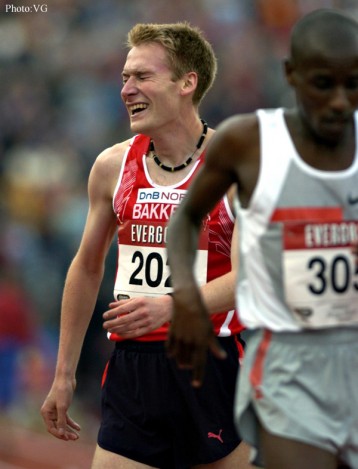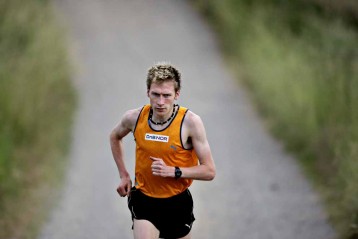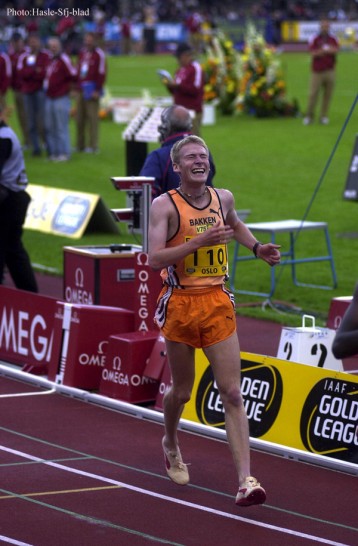

 What differentiates your 100 day program from the thousands of other books and plans flooding the market out there? Why would someone want to start it and choose it over another program?
What differentiates your 100 day program from the thousands of other books and plans flooding the market out there? Why would someone want to start it and choose it over another program?Bakken: I originally started this plan back in 2005. When I was preparing for the World Champs in Helsinki, a friend of mine approached me. He had booked the ticket and lodging for the NYC Marathon, but had done very little training for it. So I wrote him a plan based on Kenyan intensity variations and Italian periodization. It worked extremely well. In fact, he went from being a casual jogger in his first marathon to a 2:56 with this plan. Since then, I've used it with a number of other runners across practically all levels. Because it has clear periodization and plans around the way intensity is done, it gives the runner better results. Now, it’s worth noting that the plan works for 2:30-40 marathoners and upwards. For faster times, you'll have to do take a whole lot more individual things into account. What most marathon programs for the "average" marathoner do today is to start of with specialized long marathon sessions almost from day one. This increases the risk of injury while at the same time causing the runners to level off their performance after about 6-8 weeks. With a much more clear periodization and progression you can instead continue to improve over 15-18 weeks, like most elite runners do. So the plan basically applies the top marathoning principles to the average runner.
RML: What do you mean by Kenyan intensity variations? What are these?
Bakken: I noticed this the first time I went down to Kenya. I did quite extensive testing on the Kenyan runners there and to my big surprise they almost all seemed to run at almost exactly the same intensity for their workouts. Bear in mind that this is without a watch and without a heart rate monitor. I checked this using lactate acid blood samples from their fingers. From a 13:30 5K runner down to mid-12:50s. And they were all running right around the anaerobic threshold (that term is correctly no longer used as much as a scientific term - but I am referring to it here as more of an intensity level). Back in Norway, I did the same on Norwegian runners and they were all over the place. This intensity is right around 86-87% of maximum heart rate, with variation from around 80 up to around 88.
RML Interesting. So what were they doing that made them so consistent?
Bakken: You cannot get around raising your anaerobic threshold pace (pace at around 87 % of max HR) if you want to run fast, no matter what level you are at. And one of the most effective ways of doing this is training right around that intensity. But you also need to be running below this and above this. The point is that at any time in your training cycle, you must KNOW where this pace is (in terms of speed) and never get too far away from it. I tend to say that during winter training, it is a matter of knowing how much of this work you can do without letting too much of the muscular training/speed/float at higher speed suffer. You need both. In the summer however, it is the opposite, it is a matter of how little of this work you can do without going too much down at your anaerobic threshold speed. Either way, you need this as a reference.
RML: How did the Kenyans figure this out and the Norwegians (or other non-Africans) not? What went wrong with Norwegian training along the way?
Bakken: Couple of things I think. I don't think the Kenyans actually figured it out - they just felt it naturally. One thing is the altitude. At altitude, it is easier to feel the difference when you start going a bit over 87-88 % of max HR. So it is easier to distinguish. Another factor is that Kenyan runners have a different way of looking at things: Instead of "no pain, no gain," it’s, "You have to work hard, but not against your body. You have to work with it." I guess it is a combination of those things.
RML: Interesting point. So would you say Kenyans/East Africans know the right intensity and know when to back off, but that, generally speaking, non-Kenyans tend to believe that the harder things are, the better it is for the body and so maximize the hard workouts as much as possible?
Bakken: It certainly seems this way. I've trained a year in Kenya in total, spread over 15-20
 stays in addition to a year in high school (York) and college (Indiana University). Beyond a doubt, the intensity level on average was higher in the U.S. But the mileage much higher in Kenya of course.
stays in addition to a year in high school (York) and college (Indiana University). Beyond a doubt, the intensity level on average was higher in the U.S. But the mileage much higher in Kenya of course.RML: Now to the second part of your program: You talk about Italian periodization. Why do you talk about periodization specific to a country? I thought Lydiard mastered periodization and used it to with great success for the athletes he coached—-athletes like [Lasse] Viren and of course New Zealanders. Why did you choose the term “Italian periodization?” Is that different than Lydiard-esque periodization?
Bakken: If you look at Italian "school" of marathon training, they seem to cycle the training in a different way. In the Lydiard approach, it’s high mileage first, then faster, then tapering. In the Italian way, they introduce some faster 5K/10K training earlier in the cycle before going up to half-marathon-specific work and then not too many weeks with marathon-specific workouts. This is a general way of looking at it. To me, and from the results I'm seeing with the average runner taking this approach works a lot better.
RML Can any of your principles apply to non-marathoners? How about a person training specifically for the 5K or a 10K?
Bakken: To a certain degree, probably. My philosophy for the 5K is a bit different, though. I still believe in cycling the training, but when you are training for the 5K, you must never get too far away from a little bit of speed work even though you are constantly trying to raise your anaerobic threshold. So it's more of a constant mix of different training stress that matters.
RML: I want to stay on that topic. Is there any high-level advice you can give to someone who's training for a marathon and doesn't have access to the science—the blood testing, the HR monitors etc.? How can someone know during a workout that they are training and not straining; that it's ok not to experience that certain level of pain?
Bakken: The best is to use a heart rate monitor. Though not 100 % accurate, it will still do for most.
RML: What happens if I can't afford one or that chest strap thing drives me crazy. Can I get by doing the finger-to-the-neck method after the workout?
Bakken: It’s hard to rely entirely on how you feel if you want optimum performance. I've done over 6000 lactate tests and it was still a great help all the way. You can run on how you feel, but you want some kind of control at least for parts of the training. But it is all a matter of how thorough you want to do things to perform the best.
RML: I'd like to change gears now, literally. Is it true that your program advocates walking?
Bakken: Yes, it does. But keep in mind that this is for 2:45 to 5:00 marathoner. You can discuss the use of this for faster runners. There are pros and cons. But for the slower runners, this benefit is huge. You can get in loads of duration in there - and mechanical-type stress without risking injuries. And it seems that combined with high-intensity interval work (and some core marathon workouts) the combination gives the runners what they need for the last 10-15K of the marathon. But let me make an important disclaimer: I’m not just prescribing walking; I’m talking mixed running and walking. And only for the long-duration work (up to 3:30, where you run 70 %, walk 30 % - for example 7 min run, 3 min walk, 3 min run, 1 min walk)
RML: So you aren't advocating walking during the actual marathon--Gallowalking, as they call it? You are saying only walk in training, correct?
Bakken: Correct.
RML: What does walking do for the 2:45 runner and why is it 2:45 and not 2:40 or 2:50? What goes on at 2:45?
Bakken: 2:45 is only referring to the "fastest" program I've written that isn't individualized. When you get down to 2:35+ faster races, you probably have so much running in you already that there isn't the same need. That time is only approximately where I find the benefits.
RML: so walking is a way to safely build up the muscles/tendons/capillary system by minimizing stress to the body. Did I get that right?
Bakken: Not capillary system - only mechanical: tendons and muscles
RML: Why not the capillary system?
Bakken: Well, the total effect of this is likely much more prominent in the long repeat endurance work. In the "walk/runs," the intensity is too low. It will help a bit of course, but that is not the main point of it.
RML: Where did you get the idea about walking? I know the Flying Finns of the 20s---Nurmi etc.--incorporated long walks in the winter. Did you get this idea from that or are other programs/coaches advocating the walking concept and that got your attention. Did you ever walk as part of your training?
Bakken: Just from watching what happens after the 25-30K. I kept seeing that the "endurance" results of the many average runners did not seem to match their finishing times, meaning that they were over-performing in harder workouts and under-performing in the marathon. A 2-hour easy run is simply not enough if you have to be out there for 3:30 on race day. So the walk/runs is an easy way around this. So these runners would break for mechanical reasons and not for endurance reasons.

RML: Are you then advocating over-distance runs or just being out there in training for a longer period than the goal race time?
Bakken: The latter. But for marathoners from 3:30 and down, I also believe in very hard, long sessions leading up to the marathon. Many do these too early in the training though instead of doing only a few at the right time.
RML: So you are saying get out there on the roads for a longer period of time than your goal marathon time. And not go run 43K or 45K in training?
Bakken: About the same time as your goal time if you are 4 hours or faster. If your goal is 5 hours, then 3:30 to 4:00 is enough, yep. And this is only a very few times in a total training cycle--only during the marathon-specific period and only well placed in with the rest of the training.
RML: You come from a nation that just dominates the Nordic skiing world. Cross-country skiing is probably one of the hardest total-body sports there is. All that being said, I have two questions: First, why doesn't Norway produce more top-tier distance runners; does the brutal winters have something to do with that? Second, in your career were you ever pushed into moving out of running and doing cross-country skiing instead?
Bakken: We are a country of 4 million people. In the 2005 World Champion 5K final only three nations had both female and male runners: Kenya, Ethiopia, and Norway. In addition to this, Ingrid Kristiansen had the 5K, 10K, and marathon world record. We have Grete Waitz as well as the 1996 800-meter champ, Vebjørn Rodal. So it isn't too bad for such a small country. To answer your second question: no, never. I used to do lots of cross-country skiing when I was younger, but it is about talent as everything else is. Bjørn Dæhlie and Thomas Alsgård, two of the best Nordic skiers of all time (around 15 Olympic Golds) ran an 800-meter run against each other at the Bislett Games about 10 years ago at the top of their skiing career: they did about 1:57 and 2:00. So it has to do with talent for a sport like everything else. As for the winter running, I have done 100 % of my interval runs on a treadmill the last 10 years. Which is a huge benefit vs. running outdoors, so no problem at all. Plus running on snow is very comfortable and not really a problem - and I did about 50% of my time in Kenya anyways.
RML: Back to the subject of intensity. There's this famous picture of you--I like to reference it a lot--you are flat on your back after a race utterly spent. To me, that is the definition of someone who gave 100% in a race. Can you describe that moment/race?
Bakken: Yes, it is after the World championship 5K final in Edmonton where I finished 9th - and I was in the best shape of my life. I have respect for intensity control during workouts, but I also have a strong mind when it comes to races. I believe in the ability to control yourself in training, but absolutely push yourself to the limits and beyond in races is a key element to success.
RML: Is there any way to teach people that? If someone is holding back a bit in workouts and then is told to give 100% in a race, how are they conditioned mentally to do that?
Bakken: You have to know your internal motivation I think. In addition to that, the better prepared you are, the easier it is to recruit everything in you to get to that state. I believe the body has "internal limits" (read Noakes’ Central Governor) and that training optimal makes those limits the body sets out there stretched. So "mental strength" is built through better physical training as well.
RML: As a competitive runner, before the start of a race, as you were standing there on the start line looking down the track, did you ever say to yourself or think that in, say 13 minutes, you were going to be looking and feeling like that picture? Did you ever fear going through all that suffering?
Bakken: Yes, every time. But you have to look at it as a strength and not as something to fear. You have to build your training well enough so that you know, not think, that you can deal with it. The rational approach is the best.
THANKS!!




 ShareThis
ShareThis